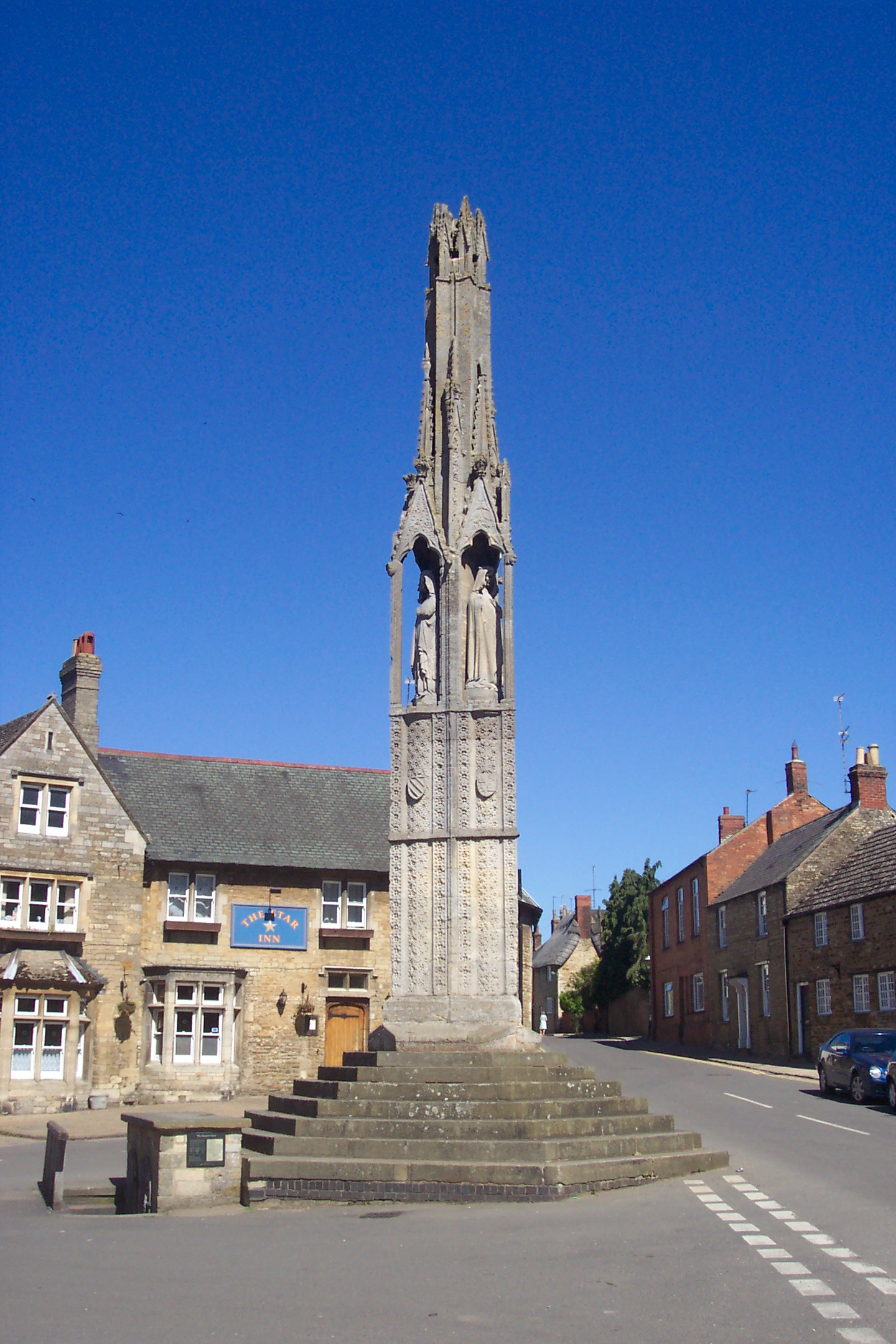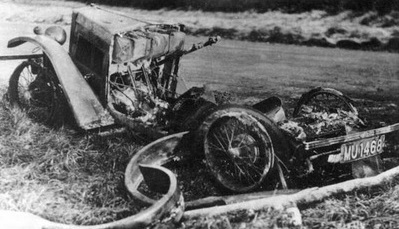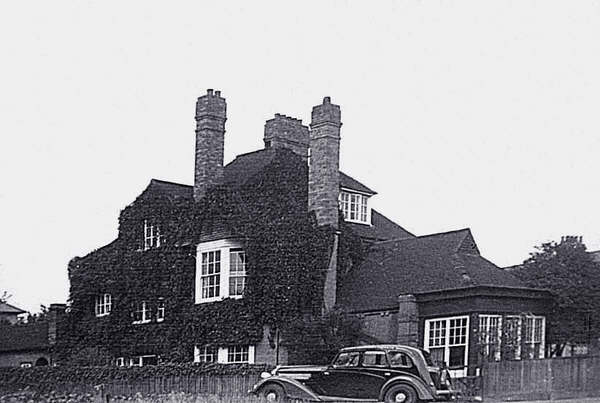|
Hardingstone
Hardingstone is a village in Northamptonshire, England. It is on the southern edge of Northampton, and now forms a suburb of the town. It is about from the town centre. The Newport Pagnell road (the B526, formerly part of the A50) separates the village from the nearby village of Wootton, which has also been absorbed into the urban area. The villages name means 'Hearding's Thorn-tree'. Governance As a village distinct from the town it has its own parish council, unlike more recent 20th and 21st century suburbs of the town. The parish includes part of the Brackmills Industrial Estate, and borders Delapré Abbey. Demographics The 2001 census showed there were 2,015 people living in the parish: 978 males and 1,037 females in 885 households. The 2011 census showed a very minor reduction to 2,014. Brackmills To the north-east of the village is the large Brackmills Industrial Estate. The estate was chosen as the site of a 400 ft wind turbine erected by the Asda supermar ... [...More Info...] [...Related Items...] OR: [Wikipedia] [Google] [Baidu] |
Wootton, Northamptonshire
Wootton is a former village about south of Northampton town centre that is now part of Northampton. Wootton is separated from Hardingstone by the Newport Pagnell Road the B526, formerly part of the A50 road. Part of Wootton is alongside the A45 dual carriageway from the M1 to Wellingborough which is seen and heard from that part of the area. History Domesday Book In the Domesday Book of 1086, Wootton is described as "Wetone". It later became Weton, Wutton and then Witton. "Wootton" appeared in the 14th century. The names probably have the Saxon origin of "Wudutun" and mean settlement or farmstead in, or by, a wood, which may have been Salcey Forest. Church The thirteenth-century Parish Church of St George the Martyr stands in the High Street in a conservation area, and is a Grade 1 listed building. It was restored in 1865. It was again restored and re-dedicated in 1991 after a £93,000 restoration programme had been successfully completed. The Rectory, west of the chur ... [...More Info...] [...Related Items...] OR: [Wikipedia] [Google] [Baidu] |
Eleanor Cross
The Eleanor crosses were a series of twelve tall and lavishly decorated stone monuments topped with crosses erected in a line down part of the east of England. King Edward I had them built between 1291 and about 1295 in memory of his beloved wife Eleanor of Castile. The King and Queen had been married for 36 years and she stayed by the King’s side through his many travels. While on a royal progress, she died in the East Midlands in November 1290. The crosses, erected in her memory, marked the nightly resting-places along the route taken when her body was transported to Westminster Abbey near London. The crosses stood at Lincoln, Grantham and Stamford, all in Lincolnshire; Geddington and Hardingstone in Northamptonshire; Stony Stratford in Buckinghamshire; Woburn and Dunstable in Bedfordshire; St Albans and Waltham (now Waltham Cross) in Hertfordshire; Cheapside in London; and Charing (now Charing Cross) in Westminster. Three of the medieval monuments – those at Ged ... [...More Info...] [...Related Items...] OR: [Wikipedia] [Google] [Baidu] |
Alfred Rouse
Alfred Arthur Rouse (6 April 1894 – 10 March 1931) was a British murderer, known as the Blazing Car Murderer, who was convicted and subsequently hanged at Bedford Gaol for the November 1930 murder of an unknown man in Hardingstone, Northamptonshire. Rouse's crime became known as the "Blazing Car Murder" due to the fact Rouse, seeking to fabricate his own death, burned to death an unknown hitchhiker whom he had rendered unconscious inside his car. The murder was notable because the identity of the victim has never been established, resulting in Rouse being tried, convicted and executed for the murder of an unknown man. Despite recent DNA testing, the identity of the victim still remains unknown. Early life Alfred Rouse was born in Milkwood Road, Herne Hill, London on 6 April 1894, one of three children born to an English father and an Irish mother. His father, Walter, was a hosier, whereas his mother was reportedly an actress who deserted her husband and children in 1900. Foll ... [...More Info...] [...Related Items...] OR: [Wikipedia] [Google] [Baidu] |
Delapré Abbey
Delapré Abbey is an English neo-classical mansion in Northamptonshire. The mansion and outbuildings incorporate remains of a former monastery, the Abbey of St Mary de la Pré (the suffix meaning "in or of the Meadow"), near the River Nene south south-east of Northampton. It was founded as a nunnery about the year 1145 devoted to the congregation of the major Abbey of Cluny in Burgundy, France. The Abbey's expansive sloping grounds are a nationally protected Wars of the Roses battlefield, as a one-time site of the advance of the Yorkists during the Battle of Northampton (1460). Founding and endowments The abbey was founded by an Anglo-Norman Earl of two counties, Simon de Senlis, during the reign of King Stephen and later benefited from its paying for a Royal Charter granted by King Edward III.House of Cluniac nuns: The abbey of Delapre, in ''A History of the County of Northampton: Vol. 2'', ed. R M Serjeantson and W R D Adkins (London, 1906), pp. 114-116. British Histor ... [...More Info...] [...Related Items...] OR: [Wikipedia] [Google] [Baidu] |
Northampton
Northampton () is a market town and civil parish in the East Midlands of England, on the River Nene, north-west of London and south-east of Birmingham. The county town of Northamptonshire, Northampton is one of the largest towns in England; it had a population of 212,100 in its previous local authority in the 2011 census (225,100 as of 2018 estimates). In its urban area, which includes Boughton and Moulton, it had a population of 215,963 as of 2011. Archaeological evidence of settlement in the area dates to the Bronze Age, Romans and Anglo-Saxons. In the Middle Ages, the town rose to national significance with the establishment of Northampton Castle, an occasional royal residence which regularly hosted the Parliament of England. Medieval Northampton had many churches, monasteries and the University of Northampton, all enclosed by the town walls. It was granted a town charter by Richard I in 1189 and a mayor was appointed by King John in 1215. The town was also the si ... [...More Info...] [...Related Items...] OR: [Wikipedia] [Google] [Baidu] |
Eleanor Of Castile
Eleanor of Castile (1241 – 28 November 1290) was Queen of England as the first wife of Edward I, whom she married as part of a political deal to affirm English sovereignty over Gascony. The marriage was known to be particularly close, and Eleanor travelled extensively with her husband. She was with him on the Ninth Crusade, when he was wounded at Acre, but the popular story of her saving his life by sucking out the poison has long been discredited. When she died, at Harby near Lincoln, her grieving husband famously ordered a stone cross to be erected at each stopping-place on the journey to London, ending at Charing Cross. Eleanor was better educated than most medieval queens and exerted a strong cultural influence on the nation. She was a keen patron of literature and encouraged the use of tapestries, carpets and tableware in the Spanish style, as well as innovative garden designs. She was also a successful businesswoman, endowed with her own fortune as Countess of Pont ... [...More Info...] [...Related Items...] OR: [Wikipedia] [Google] [Baidu] |
Far Cotton
Far Cotton is a district in the civil parish of Far Cotton and Delapre, in the town of Northampton, in the county of Northamptonshire, England and many years ago a village in its own right. The population is included in the Delapre and Briar Hill Ward of Northampton Borough Council. Location Far Cotton is due south of the town centre, beyond Cotton End - hence the 'Far' - and just south of the River Nene. It is roughly rectangular in shape with the river and Northampton branch of the Grand Union Canal forming its northern boundary. The railway line, part of the Northampton Loop Line just south of Northampton railway station is on the western edge. The A5076 ring road is the southern boundary and Delapré Abbey's park forms the eastern boundary up to the A45 road. Administration From elections on and after 2011, Far Cotton is in the Parish of St Mary and Delapre Ward of the Northampton Borough Council. On Northampton County Council Far Cotton is in Delapre and Rushmere Divisio ... [...More Info...] [...Related Items...] OR: [Wikipedia] [Google] [Baidu] |
West Northamptonshire
West Northamptonshire is a unitary authority area covering part of the ceremonial county of Northamptonshire, England, created in 2021. By far the largest settlement in West Northamptonshire is the county town of Northampton. Its other significant towns are Daventry, Brackley and Towcester; the rest of the area is predominantly agricultural villages though it has many lakes and small woodlands and is passed through by the West Coast Main Line and the M1 and M40 motorways, thus hosting a relatively high number of hospitality attractions as well as distribution centres as these are key English transport routes. Close to these is the leisure-use Grand Union Canal. The district has remains of a Roman town Bannaventa, with relics and finds in the main town museums, and its most notable landscape and the mansion is Althorp. History West Northamptonshire was formed on 1 April 2021 through the merger of the three non-metropolitan districts of Daventry, Northampton, and South Nor ... [...More Info...] [...Related Items...] OR: [Wikipedia] [Google] [Baidu] |
Daniel Defoe
Daniel Defoe (; born Daniel Foe; – 24 April 1731) was an English writer, trader, journalist, pamphleteer and spy. He is most famous for his novel '' Robinson Crusoe'', published in 1719, which is claimed to be second only to the Bible in its number of translations. He has been seen as one of the earliest proponents of the English novel, and helped to popularise the form in Britain with others such as Aphra Behn and Samuel Richardson. Defoe wrote many political tracts, was often in trouble with the authorities, and spent a period in prison. Intellectuals and political leaders paid attention to his fresh ideas and sometimes consulted him. Defoe was a prolific and versatile writer, producing more than three hundred works—books, pamphlets, and journals — on diverse topics, including politics, crime, religion, marriage, psychology, and the supernatural. He was also a pioneer of business journalism and economic journalism. Early life Daniel Foe (his original name) was pr ... [...More Info...] [...Related Items...] OR: [Wikipedia] [Google] [Baidu] |
A Tour Thro' The Whole Island Of Great Britain
''A Tour Thro' the Whole Island of Great Britain'' is an account of his travels by English author Daniel Defoe, first published in three volumes between 1724 and 1727. Other than ''Robinson Crusoe'', ''Tour'' was Defoe's most popular and financially successful work during the eighteenth century. Pat Rogers notes that in Defoe’s use of the “literary vehicle (the ‘tour’ or ‘circuit’) that could straddle the literal and the imaginative,” “Nothing...anticipated Defoe’s Tour”. Thanks in part to his extensive travels and colourful background as a soldier, businessman, and spy, Defoe had “hit on the best blend of objective fact and personal commentary” in his descriptions of locations and trips around Britain. Composition and structure The ''Tour'' is roughly divided into several tours, or circuits, around Britain. Volume 1 contains three letters. The first two, Through Essex, Colchester, Harwich, Suffolk, Norfolk, and Cambridgeshire, and through Kent Coast, Ma ... [...More Info...] [...Related Items...] OR: [Wikipedia] [Google] [Baidu] |
Great Fire Of Northampton
The Great Fire of Northampton occurred in September 1675 in Northampton in Northamptonshire, England. The blaze was caused by sparks from an open fire on St. Mary’s Street, near Northampton Castle. The fire devastated the town centre, destroying about 700 of the town's 850 buildings, including All Saints church, in six hours. Three quarters of the town was destroyed, 11 people died and about 700 families were made homeless. Many people escaped the fire by going through Welsh House on the market square to safety. Local people and businesses raised £25,000 towards re-building the town centre based around the Market Square. Streets were widened to help prevent a re-occurrence. King Charles II donated 1,000 tons of timber from Salcey Forest for the re-building. William A. Shaw (ed.Donation listed in Shaw's ''Calendar of Treasury Books'' ''Calendar of Treasury Books, Volume 6: 1679-1680.'' (1913), pp. 11-18. British History Online A commemorative statue of the king (dressed in a R ... [...More Info...] [...Related Items...] OR: [Wikipedia] [Google] [Baidu] |
Edmund The Martyr
Edmund the Martyr (also known as St Edmund or Edmund of East Anglia, died 20 November 869) was king of East Anglia from about 855 until his death. Few historical facts about Edmund are known, as the kingdom of East Anglia was devastated by the Vikings, who destroyed any contemporary evidence of his reign. Coins minted by Edmund indicate that he succeeded Æthelweard of East Anglia, as they shared the same moneyers. He is thought to have been of East Anglian origin, but 12th century writers produced fictitious accounts of his family, succession and his rule as king. Edmund's death was mentioned in the ''Anglo-Saxon Chronicle'', which relates that he was killed in 869 after the Great Heathen Army advanced into East Anglia. Medieval versions of Edmund's life and martyrdom differ as to whether he died in battle fighting the Great Heathen Army, or if he met his death after being captured and then refusing the Viking leaders' demand that he renounce Christ. A popular cult emerg ... [...More Info...] [...Related Items...] OR: [Wikipedia] [Google] [Baidu] |







.jpg)